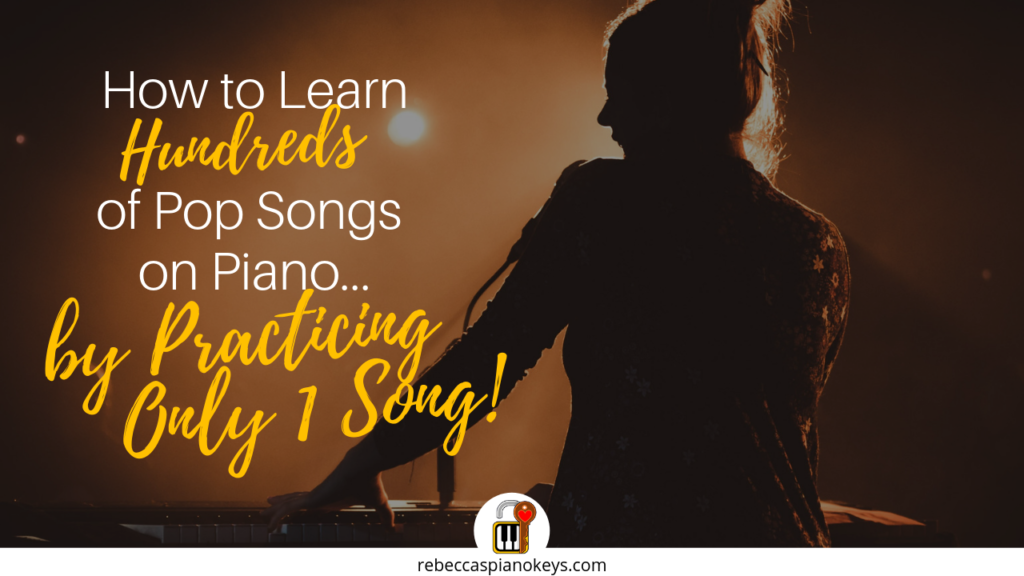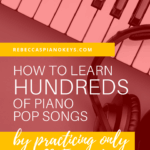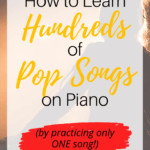Last Updated on January 24, 2022 by Rebecca
Have you heard of 4-chord songs? Did you know know that there is one particular chord progression that is used in literally hundreds of pop songs?
It may seem too good to be true, but I promise you, it’s not! If you take the time to learn how to play just one pop song on the piano, you will simultaneously master hundreds of other pop songs.
It’s like a 2-for-1 deal for your piano learning… except it’s more like 200-for-1! (Or even more!)
What’s the secret?
The I-V-vi-IV chord progression.
(And trust me, it’s the worst-kept secret in the music industry.)
Basically, what it comes down to is that somewhere along the way, people decided the I-V-vi-IV chord progression sounded really good, so everyone started using it.
At this point, it’s been done to death, and basically every pop song ever uses this same chord progression.
(That’s an exaggeration, but sometimes it doesn't feel like it is.)
Now, this is not to say every song sounds exactly the same. Just because 2 songs use the same chord progression doesn’t mean they are identical.
They can have different melodies, a different combination of instruments, different lyrics, different key signatures. They can be very different.
They’re just built on the same chord progression. They have the same bone structure.

So how exactly does this magical I-V-vi-IV chord progression work?
The roman numerals in the chord progression tell you which scale degree to use. I represents the first note of a scale, V represents the 5th note of a scale, etc.
Uppercase numerals represent major keys; lowercase numerals represent minor keys.
(Sidenote: What’s really handy about the roman numerals is that they show the relationship between chords rather than the chords themselves. Which means you can transpose your chord progression into any key signature you want.)
In the key of C major, the I-V-vi-IV chord progression uses the chords C-G-Am-F.
All you need to do is practice these 4 chords until you can switch quickly and smoothly from one to the next. Then you just play those same 4 chords, in the same order, over and over again, while you sing along the lyrics to your favourite I-V-vi-IV pop song.
BOOM!
You just learned how to play “Last Kiss” by Wayne Cochrane.
(Although you're probably more familiar with the version by Pearl Jam.)
This was one of the first songs I-V-vi-IV songs I ever learned on guitar… and my mom hated it!
She says she remembers being 6 years old and crying every time it came on the radio. So any time I would start singing when I was home for a visit, she'd yell from the other room, “Don't you play that song in my house!”
If you're like me and you love a good sad song, you can easily master “Last Kiss” on the piano, and once you've done that, you'll find you've also mastered “Someone Like You” by Adele!
Would you rather learn a love song to serenade your special someone? You can master the I-V-vi-IV chord progression by learning to play “Can You Feel the Love Tonight” by Elton John (who doesn't love The Lion King?), “I'm Yours” by Jason Mraz, or “Say You Won't Let Go” by James Arthur.
Is country music more your style? No worries! Learn the magical I-V-vi-IV chord progression by playing “I Wanna Talk About Me” by Toby Keith, or “Cruise” by Florida Georgia Line.
Are you more into golden oldies? How about “With or Without You” by U2, “Always on my Mind” by Brenda Lee, or “Beast of Burden” by The Rolling Stones.
None of these options are your style? Maybe you like “When I Come Around” by Greenday, “Demons” by Imagine Dragons, “Hey, Soul Sister” by Train, or “Girls Like You” by Maroon 5?

Remember, the best part is that if you learn any one of the I-V-vi-IV songs I've mentioned above, you've learned all of the songs I've mentioned above!
And that's just the tip of the iceberg! There are tons of other songs that are built on that same I-V-vi-IV chord progression.
But it gets even better!
Try these same 4 chords in different orders and you’ll find there are even more songs you can play! Songs like:
- “Alejandro” by Lady Gaga
- “Breakeven” by The Script (a favourite of mine)
- “Let Her Go” by Passenger
- “Apologize” by OneRepublic
- “Despacito” by Luis Fonsi ft. Justin Bieber (if you're not completely sick of this song by now)
- “Little Talks” by Of Monsters and Men
- “Numb” by Linkin Park
- “Say Something” by Great Big World (I hate that one, but lots of people love it)
And so many more!
Need to see the I-V-vi-IV chord progression in action to believe it?
Check out this video by the group Axis of Awesome. (It has a couple F-bombs in it, just a forewarning if that’s something that will bother you. But there are only 2!)
This video was filmed at the 2009 Melbourne International Comedy Festival. I discovered it in around 2012 when I was teaching myself guitar, and my… mind… was… blown!
In all my years of piano lessons, I’d mastered just about every chord imaginable… but no one had ever taught how these chords related to actual songs. All those years I thought they were just finger exercises!
So I sat in my basement apartment with my new guitar, bought a capo, practiced day and night (literally, I feel bad for my upstairs landlord) until I had mastered 4 chords, and BOOM, I was a guitar rock star, singing my favourite songs wherever I went!
(Ahem… singing “Last Kiss” at my mom's house and making her cry… I'm the worst!)
And it really wasn't hard to transfer all this over to the piano!
Are the songs in the Axis of Awesome video too out-dated for you?
Rick Beato published a video in 2017 with a more modern sampling of songs. And he goes a bit more in detail explaining how the chord progression works and how the same 4 chords are sometimes mixed into different orders.
But wait! It’s not JUST modern pop music that uses this chord progression.
This chord progression dates back all the way to the Baroque era! Don’t believe me? Check out Rob Paravonian’s “Pachelbel Rant” from 2006:
Ready to get started learning to play pop songs on piano?
This article by TrueFire.com lists 229 Easy Guitar Songs You Can Play with Just 4 Chords. (And as a bonus, it does a really good job of illustrating for you how the I-V-vi-IV chord progression can be applied to every key signature.) And remember, chords are chords! Guitar websites are a great resource for finding songs to learn on the piano!
Wikipedia also has an extensive list of songs built on the I-V-vi-IV chords, in various orders.

What do you think?
Did you already know about 4-chord songs and the I-V-vi-IV chord progression? Or is this a mind-blowing bit of new intel for you? Do you view the popularity of this chord progression as a negative thing or a positive thing? (That last question is a huge debate among music lovers, so I'm really interested to hear which side you're on!) If you were to start learning piano by learning a 4-chord song, which song would you choose to start with? I love hearing from my readers, so share your thoughts in the comments section!





Wow! Thanks for pointing this out. Very interesting!
Hi Jonna, I’m glad you enjoyed it! 🙂
Hi,
I don’t know anything about piano or music but this is crazy that that particular cord is used in soooo many songs! Cool post!
Hi Erin,
Yes, it’s incredible! It certainly helps beginner musicians get a quick boost of success to jump start their learning journey! A strong beginning can be a huge motivator to keep at it and further develop skills! Glad you liked the post! 🙂
To go further, listen to mashups of pop songs to hear that chord progression. They basically just cycle through the chord progression, just switching up which song it is using that progression, giving a seamless mashup!
Hi Sally,
Exactly! That’s such a great point! An excellent way to see chord progressions in action and see how different melodies can be built over the same chord progression. Do you play a musical instrument?